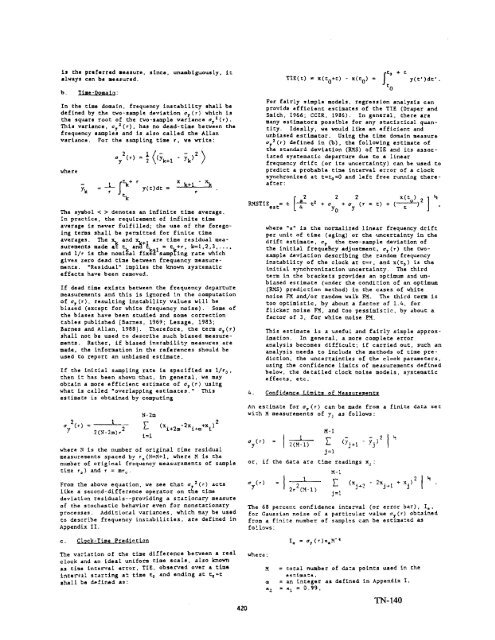NIST Technical Note 1337: Characterization of Clocks and Oscillators
NIST Technical Note 1337: Characterization of Clocks and Oscillators
NIST Technical Note 1337: Characterization of Clocks and Oscillators
Create successful ePaper yourself
Turn your PDF publications into a flip-book with our unique Google optimized e-Paper software.
is ~he preferred measure, since, unambiguously, it ft et + r:always cen be measured.y(t·)dt'.tob. Iime-pomal0:For fairly simple models, regression analysis canIn the ~ime domain, frequency inscability shall beprovide efficient escimaees <strong>of</strong> the TIE (Draper <strong>and</strong>defined by the cwo-sample deviation ~,(r) which isSmieh. 1966: CcrR, 1986). In general, ehere arethe square root <strong>of</strong> the cwo-sample variance o,1(r),many estimators possible for any staciseical quanti~y.Ideally, ve would like an efficiene <strong>and</strong>This variance, c,J(r). has no dead-time between thefrequency samples <strong>and</strong> is also called the Allanunbiased es~imator. Using the time domain measurevariance. For che sampling time r. ve WTlte:a,2(r) defined in (b), the follOWing estima~e <strong>of</strong>vhere~ + r; --;- fie y(~)d~ =~x k+lThe symbol < > denotes an infinite time average.In practice, the requirement <strong>of</strong> infinite timeaverage is never fulfilled; the use <strong>of</strong> ~he foregoingcerms shall be permitted for finite timeaverages. The ~ <strong>and</strong> ~+ are time residual measurementsmade aE 7K ana ~ 1 = ~+r. k=1.2.3 ...••<strong>and</strong> l/r is the nominal fixed sampting ra~e whichgives zero dead time between frequency measuremencs."Residuai" implies the kno~ syseematiceffects have been removed.If dead cime exists becween the frequency departuremeasurements <strong>and</strong> this is ignored in the computation<strong>of</strong> c,(r), resul~ing instabilicy values vill bebiased (except for vhite frequency noise). Some <strong>of</strong>the biases have been seudied <strong>and</strong> some correctiontables published [Barnes, 1969; Lesage. 1983;Barnes <strong>and</strong> Allan, 19881. Therefore. the term a,(r)shall not be used to describe such biased measurements.Raeher. if biased instability measures aremade, the info~ation in the references should beused to repore an unbiased eseima~e.If che inieial sampiing race is specified as l/ro ,then it has been shovn~hat. in general, we mayobeain a more efficienc estimaee <strong>of</strong> a,(r) usingvha~ is called "overlapping eseimaees." Thisescimaee is obeained by computingN-2mLi=lwhere N is che number <strong>of</strong> original time residualmeasuremenes spaced by r.(N=~+l, where M is ~henumber <strong>of</strong> originai fr~quency measur~ments <strong>of</strong> sampleei:e r.) <strong>and</strong> T " mT•.From ~he above equaeion, We see thae a,1(r) actsiike a second-difference operator on the timedeviation residuals--providing a stationary measure<strong>of</strong> the scochascic behavior eVen for nonscacionaryprocesses. Additio~al variances, which may ~e usedco describe frequency instabilities, are deflned inA?pendix I I.c. ~L9ck-Time Prediceionthe sc<strong>and</strong>ard deviation (R~S) <strong>of</strong> TIE <strong>and</strong> ies associacedsyseemacic depar~ure due to 4 linearfrequency drifc (or ics uncertainty) can be U3ed topredict a probable ti=e interval error <strong>of</strong> a clocksynchronized at t"t.=O <strong>and</strong> left free running thereafter:1l(t)2]1tR.'!STtE "t [2 t2 + a 2 + a 2 (r t) + (--2-)est 4 Yo y twhere "a" is the normalized linear frequency drifeper unic <strong>of</strong> cime (aging) or the uncertainty in thedrift estimace, a, the two-sample devia~ion <strong>of</strong>the initial freque~cy adjustment, a,(r) the cwosampledeViation describing ehe r<strong>and</strong>om frequencyinseabiliey <strong>of</strong> the clock ae t=T, <strong>and</strong> x(t.) i5 theinieial synchroniza~ion uncertainey. The ehirdterm in the brackees provides an opeimum <strong>and</strong> unbiasedescimate (under the condition <strong>of</strong> an optimum(R~) prediction meehod) in the cases <strong>of</strong> whitenoise FM <strong>and</strong>/or r<strong>and</strong>om walk FM. The third term istoo optimistic, by about a faccor <strong>of</strong> 1.4, forflicker noise FM, <strong>and</strong> coo pessimistic, by about afactor <strong>of</strong> 3, for whice noise P~.This estimaee is a useful <strong>and</strong> fairly simple approximaeion.In general. a more complete erroranalysis becomes difficult; if carried out. such ananalysis needs to inclUde the methods <strong>of</strong> time prediction,the uncertainties <strong>of</strong> the clock parameters,using ehe confidence limits <strong>of</strong> measurements definedbelow. che detailed clock noise models, syseematiceffaces. etc.4. Confidence Limits <strong>of</strong> ~easurementsAn eseimaee for Oy(T) can be made from a finiee daea setwieh Mmeasuremenes <strong>of</strong> Yj as follows:M-la ( r)I ---l.- - 2y 2(~-l) L (Yj +1- Yj)j=lor, if ehe data are time rudings It; :M-l1I~a/r) L (X j+ 2- 2xj + l + x j2r2(~-1))j=l>,2IojIThe 68 percene confidence in~erval (or error bar), I.,for Gaussian noise <strong>of</strong> a particular value a,(r) obtainedfrOm a finite number <strong>of</strong> .ampl~s can be estimated asfo!.lo"s:The variation <strong>of</strong> the time difference be~~een a realclock And an ideal uniform ~ime scale, also knovnas ei~e intervai error, TIE, observed over a timelnter-I.11 starting a: time t. And ending at t.+tshall be defined as:420wher.. :to~alnumber <strong>of</strong> data poln~s used in the@'f1':lala~e. Ian ineeger as defined in A?pendix r,z "1 = 0.99,TN-140
















